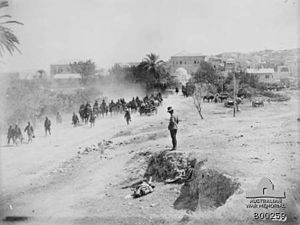| Capture of Jenin | |||||||
|---|---|---|---|---|---|---|---|
| Part of the Middle Eastern theatre of World War I | |||||||
 Jenin on 21 September 1918 | |||||||
| |||||||
| Belligerents | |||||||
|
| |||||||
| Commanders and leaders | |||||||
|
|
| ||||||
| Units involved | |||||||
|
Egyptian Expeditionary Force Desert Mounted Corps Australian Mounted Division |
Yildirim Army Group Seventh Army Eighth Army | ||||||
| Casualties and losses | |||||||
| unknown | unknown casualties, 8,000 prisoners | ||||||
The Capture of Jenin occurred on 20 September 1918, during the Battle of Sharon which together with the Battle of Nablus formed the set piece Battle of Megiddo fought between 19 and 25 September during the last months of the Sinai and Palestine Campaign of the First World War. During the cavalry phase of the Battle of Sharon carried out by the Desert Mounted Corps, the 3rd Light Horse Brigade, Australian Mounted Division attacked and captured the town of Jenin located on the southern edge of the Esdraelon Plain (also known as the Jezreel Valley and the plain of Armageddon) 40–50 miles (64–80 km) behind the front line in the Judean Hills. The Australian light horse captured about 2,000 prisoners, the main supply base and the ordnance depot of the Seventh and the Eighth Armies in and near the town. They also cut the main road from Nablus and a further 6,000 Ottoman Empire and German Empire prisoners, were subsequently captured as they attempted to retreat away from the Judean Hills.
The Egyptian Expeditionary Force (EEF) cavalry had ridden through a gap on the Mediterranean Sea coast, created by the infantry during the Battle of Tulkarm, to capture the two Ottoman armies' main lines of communication and supply north of the Judean Hills, while the infantry battles continued. On 20 September, the Desert Mounted Corps captured Afulah, Beisan and Jenin on the Esdrealon Plain. The next day the headquarters of the Seventh Army at Nablus, and the General Headquarters (GHQ) of the Yilderim Army Group at Nazareth, were both captured, while Haifa was captured two days later. During a subsequent early morning attack on 25 September, a German rearguard was captured during the Battle of Samakh, which ended the Battle of Sharon. During these operations the greater part of one Ottoman army was captured in the Judean Hills and at Jenin. These and other battles fought during the Battle of Megiddo including the Battle of Nablus and Third Transjordan attack, forced the retreating Ottoman Fourth, and remnants of the Seventh and the Eighth Armies, to the eastern side of the Jordan River. As they withdrew northwards towards Damascus they were pursued by the Desert Mounted Corps.
After the infantry established a gap in the Ottoman front line on the coast early on the morning of 19 September, the Australian Mounted Division's 3rd and 4th Light Horse Brigades (less the 5th Light Horse Brigade temporarily detached to the 60th Division) in reserve, followed the 4th Cavalry Division north on the Plain of Sharon and across the Mount Carmel Range, by the Musmus Pass, to Lejjun on the Esdrealon Plain. While the 4th Light Horse Brigade remained to garrison Lejjun and provide various guards for artillery, supplies, and corps headquarters before being ordered to capture Samakh, the 3rd Light Horse Brigade advanced to Jenin, where the 9th and 10th Light Horse captured the town after a brief fire fight. Subsequently, these two regiments captured some 8,000 Ottoman soldiers, who had been attempting to retreat northwards out of the Judean Hills, during the night of 20/21 September. The outnumbered Australian Light Horsemen were reinforced as quickly as possible, and the majority of the prisoners were marched back into holding camps, near Lejjun in the morning. The 3rd Light Horse Brigade remained in the area to garrison Jenin until they advanced to capture Tiberias on 25 September 1918, before participating in the pursuit to Damascus.
© MMXXIII Rich X Search. We shall prevail. All rights reserved. Rich X Search
